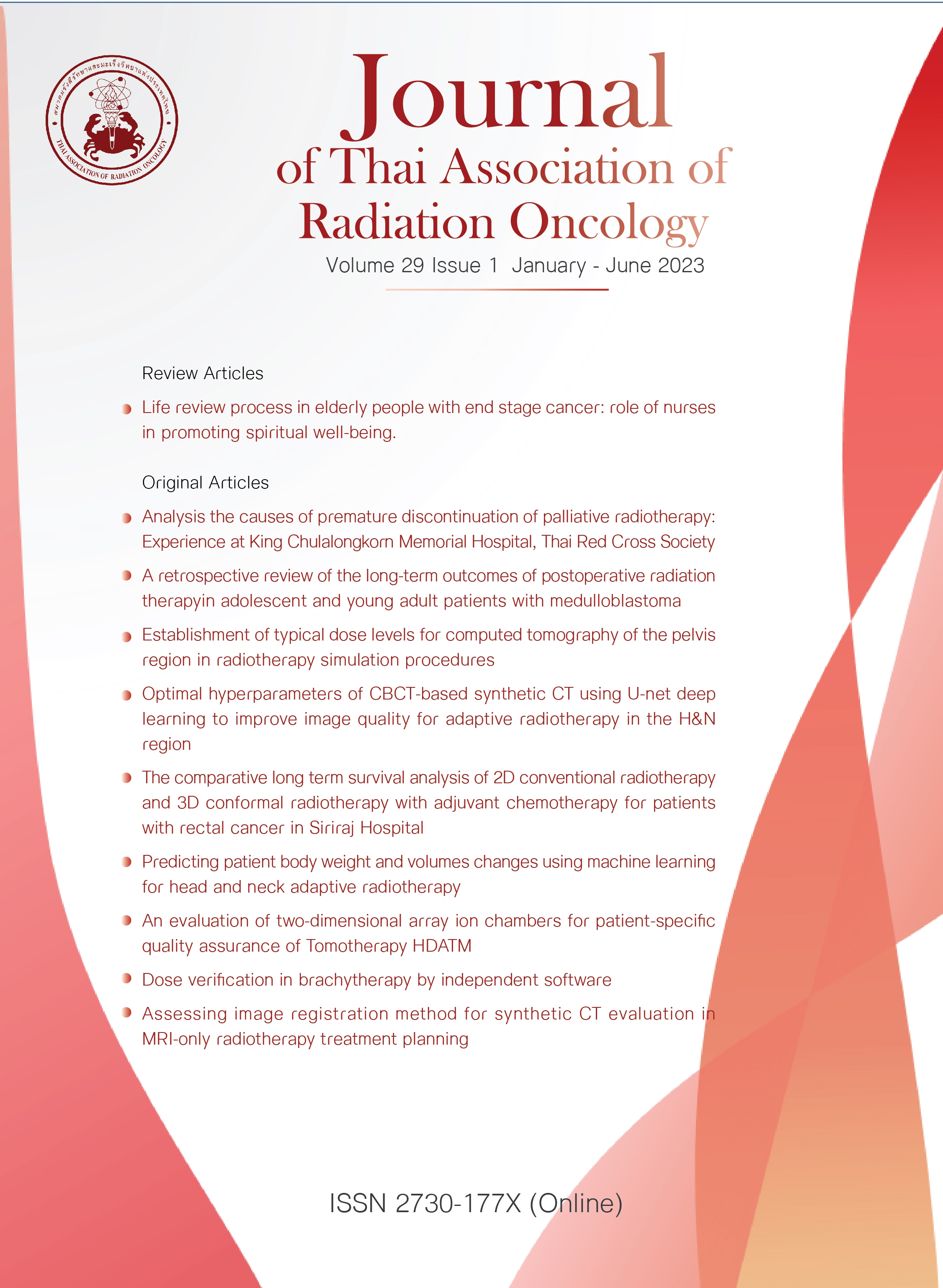ไฮเปอร์พารามิเตอร์ที่เหมาะสมของการสร้างภาพเอกซเรย์คอมพิวเตอร์สังเคราะห์จากภาพเอกซเรย์คอมพิวเตอร์ลำรังสีกรวยด้วยการเรียนรู้เชิงลึกชนิดยูเน็ตเพื่อเพิ่มคุณภาพของภาพสำหรับการรักษาเทคนิครังสีแบบปรับแผนในบริเวณศีรษะและลำคอ
คำสำคัญ:
เอกซเรย์คอมพิวเตอร์สังเคราะห์, เอกซเรย์คอมพิวเตอร์ลำรังสีกรวย, การเรียนรู้เชิงลึก, ยูเน็ต, ไฮเปอร์พารามิเตอร์บทคัดย่อ
หลักการและเหตุผล: การนำภาพเอกซเรย์คอมพิวเตอร์ชนิดลำรังสีกรวย (Cone-beam computed tomography: CBCT) มาใช้ในการรักษาด้วยรังสีแบบปรับแผนสำหรับมะเร็งศีรษะและลำคอ (Head and neck cancer: HNC) สามารถทำได้ง่ายและไม่มีการเพิ่มปริมาณรังสี แต่อย่างไรก็ตามยังมีข้อจำกัดด้านความถูกต้องของค่า HU และคุณภาพของภาพ เมื่อเร็วๆนี้ หลายงานวิจัยได้เสนอให้ใช้การเรียนรู้เชิงลึก (Deep learning: DL) เพื่อสร้างภาพเอกซเรย์คอมพิวเตอร์สังเคราะห์ (Synthetic CT: sCT) ซึ่งคุณภาพของภาพจากวิธีการนี้ขึ้นอยู่กับการตั้งค่าไฮเปอร์พารามิเตอร์
วัตถุประสงค์: เพื่อหาค่าไฮเปอร์พารามิเตอร์ที่เหมาะสมของแบบจำลองการเรียนรู้เชิงลึกชนิดยูเน็ต (U-net) สำหรับการสร้างภาพ sCT ในการรักษาด้วยรังสีแบบปรับแผนสำหรับ HNC
วัสดุและวิธีการ: การศึกษานี้ใช้แบบจำลอง U-net โดยใช้ภาพทั้งหมด 3,491 คู่จากชุดข้อมูลภาพเอกซเรย์คอมพิวเตอร์วางแผนการรักษา (pCT) และ CBCT ของ HNC 40 ราย โดยแบ่งข้อมูลเป็น 80% และ 20% สำหรับการฝึกและทดสอบตามลำดับ เพื่อหาค่าไฮเปอร์พารามิเตอร์ที่เหมาะสม ค่าอัตราการเรียนรู้, ขนาดแบทช์, และรอบในการฝึก ได้มีการปรับแต่งทั้งหมด 45 เงื่อนไข และมีการประเมินคุณภาพของภาพระหว่างภาพ pCT และ sCT ดังนี้ ค่าผิดพลาดสัมบูรณ์เฉลี่ย (MAE) และค่าผิดพลาดกำลังสองเฉลี่ยของราก (RMSE), อัตราส่วนสัญญาณต่อสัญญาณรบกวนสูงสุด (PSNR) และดัชนีความคล้ายคลึงกันของโครงสร้าง (SSIM) รวมถึงเวลาในการฝึกแบบจำลอง
ผลการศึกษา: ไฮเปอร์พารามิเตอร์ที่เหมาะสมประกอบด้วยค่าอัตราการเรียนรู้ที่ 1e-3, ขนาดแบทช์ที่ 8, และรอบการฝึกแบบจำลองที่ 200 ค่า MAE, RMSE และ PSNR มีค่าที่ดีขึ้นจาก 53.15±40.09, 153.99±79.78 และ 47.91±4.98 เป็น 41.47±30.59, 130.39±78.06 และ 49.93±6.00 ตามลำดับ ขณะที่ค่า SSIM มีค่าคงที่ งานวิจัยนี้พบว่าค่าอัตราการเรียนรู้คือค่าที่มีความสำคัญในการฝึกแบบจำลอง โดยแบบจำลอง U-net สามารถลดสิ่งแปลกปลอมและสัญญาณรบกวนได้เป็นอย่างดี เวลาการฝึกแบบจำลองมีค่าเฉลี่ยที่ 6 ชั่วโมง 36.6 นาที (398 มิลลิวินาที/ขั้น) โดยใช้เวลาการสร้างภาพ sCT น้อยกว่า 10 วินาที
ข้อสรุป: การปรับไฮเปอร์พารามิเตอร์ที่เหมาะสมสามารถช่วยเพิ่มคุณภาพของภาพ sCT ให้ดีขึ้น การศึกษานี้แสดงให้เห็นว่าภาพ CBCT สามารถนำมาใช้สำหรับการรักษาด้วยรังสีแบบปรับแผนใน HNC ได้
References
Spencer S. Head and neck cancers: Advantages of advanced radiation therapy and importance of supportive care. Journal of the National Comprehensive Cancer Network. 2018 May 1;16(5S):666-9. doi: 10.6004/jnccn.2018.0049.
Belshaw L, Agnew CE, Irvine DM, Rooney KP, McGarry CK. Adaptive radiotherapy for head and neck cancer reduces the requirement for rescans during treatment due to spinal cord dose. Radiation Oncology. 2019 Nov 1;14(1): 1-7. doi: 10.1186/s13014-019-1400-3.
Yeh SA. Radiotherapy for head and neck cancer. Semin in Plastic Surgery. 2010 May 21;24(02):127–136. doi: 10.1055/s-0030-1255330.
Castadot P, Lee JA, Geets X, Grégoire V. adaptive radiotherapy of head and neck cancer. Vol. 20, Seminars in Radiation Oncology. 2010 Apr 1;20(02):84–93. doi: 10.1016/j.semradonc.2009.11.002.
Schwartz DL. Current progress in adaptive radiation therapy for head and neck cancer. Curr Oncol Rep. 2012 Apr;14(2):139–47. doi: 10.1007/s11912-012-0221-4.
Sonke JJ, Aznar M, Rasch C. Adaptive radiotherapy for anatomical changes. Semin Radiat Oncol. 2019;29(3):245–57. doi: 10.1016/j.semradonc.2019.02.007.
Posiewnik M, Piotrowski T. A review of cone-beam CT applications for adaptive radiotherapy of prostate cancer. Physica Medica. 2019;59:13–21. doi: 10.1016/j.ejmp.2019.02.014.
Søvik Å, Rødal J, Skogmo HK, Lervåg C, Eilertsen K, Malinen E. Adaptive radiotherapy based on contrast enhanced cone beam CT imaging. Acta Oncol (Madr). 2010 Oct 1;49(7):972–7. doi: 10.3109/0284186X.2010.498433.
Buchanan A, Mcdavid D. Characterization and correction of cupping effect artefacts in cone beam CT. Dentomaxillofac Radiol. 2012 Mar 1;41:217–23. doi: 10.1259/dmfr/19015946.
Jaju P, Jain M, Singh A, Gupta A. Artefacts in cone beam CT. Open J Stomatol. 2013 Jan 1;03:292–7. 2013;03(05):292–7. doi: 10.4236/ojst.2013.35049.
Schulze R, Heil U, Groß D, Bruellmann D, Dranischnikow E, Schwanecke U, et al. Artefacts in CBCT: a review. Dentomaxillofac Radiol. 2011 Jul 1;40:265–73. doi: 10.1259/dmfr/30642039.
Kida S, Nakamoto T, Nakano M, Nawa K, Haga A, Kotoku J, et al. Cone beam computed tomography image quality improvement using a deep convolutional neural network. Cureus. 2018 Apr 29;10(4). doi: 10.7759/cureus.2548.
Chen L, Liang X, Shen C, Jiang S, Wang J. Synthetic CT generation from CBCT images via deep learning. Med Phys. 2020 Mar 1;47(3):1115–25. doi: 10.1002/mp.13978.
Barateau A, de Crevoisier R, Largent A, Mylona E, Perichon N, Castelli J, et al. Comparison of CBCT-based dose calculation methods in head and neck cancer radiotherapy: from Hounsfield unit to density calibration curve to deep learning. Med Phys. 2020 Oct 1;47(10):4683–93. doi: 10.1002/mp.14387.
Vincent P, Larochelle H, Lajoie I, Bengio Y, Manzagol PA, Bottou L. Stacked denoising autoencoders: Learning useful representations in a deep network with a local denoising criterion. Journal of machine learning research. 2010 Dec 1;11(12). doi: 10.5555/1756006.1953039.
Han X. MR-based synthetic CT generation using a deep convolutional neural network method. Med Phys. 2017 Feb 1;44. doi: 10.1002/mp.12155.
Ioffe S, Szegedy C. Batch normalization: accelerating deep network training by reducing internal covariate shift. International Conference on Machine Learning. 2015 Jun 1;37:448-456. doi: 10.5555/3045118.3045167.
Nair V, Hinton GE. Rectified linear units improve restricted boltzmann machines. International Conference on Machine Learning. 2010 Jan 1;807–14. doi: 10.5555/3104322.3104425.
Smith LN. A disciplined approach to neural network hyper-parameters: Part 1 -- learning rate, batch size, momentum, and weight decay. arXiv preprint arXiv:1803.09820. 2018 Mar 26. doi: 10.48550/arXiv.1803.09820.
Rashmi, Ghose U, Gupta M. Comparative design analysis of optimized learning rate for convolutional neural network. In: Sharma H, Saraswat M, Kumar S, Bansal JC, editors. Intelligent Learning for Computer Vision. Singapore: Springer Singapore; 2021;339–52. doi: 10.1007/978-981-33-4582-9_26.
Qian X, Klabjan D. The impact of the mini-batch size on the variance of gradients in stochastic gradient descent. arXiv preprint arXiv:2004.13146. 2020 Apr 27. doi: 10.48550/arXiv.2004.13146.
Afaq S, Rao S. Significance of epochs on training a neural network. International Journal of Scientific & Technology Research. 2020 Jun;9(06):485-8.
Ronneberger O, Fischer P, Brox T. U-net: convolutional networks for biomedical image segmentation. International Conference on Medical image computing and computer-assisted intervention. 2015 Oct 5;234-241. doi: 10.1007/978-3-319-24574-4_28.
Zhou Z, Siddiquee MMR, Tajbakhsh N, Liang J. Unet++: redesigning skip connections to exploit multiscale features in image segmentation. IEEE Trans Med Imaging. 2020 Jun;39(6):1856–67. doi: 10.1109/TMI.2019.2959609.
Krogh A, Hertz JA. A simple weight decay can improve generalization. International Conference on Neural Information Processing Systems. 1991;4:950–7. doi: 10.5555/2986916.2987033.
Bergstra J, Bengio Y. Random search for hyper-parameter optimization. Journal of machine learning research. 2012 Feb 1;13(2). doi: 10.5555/2188385.2188395.
Li Y, Zhu J, Liu Z, Teng J, Xie Q, Zhang L, Liu X, Shi J, Chen L. A preliminary study of using a deep convolution neural network to generate synthesized CT images based on CBCT for adaptive radiotherapy of nasopharyngeal carcinoma. Physics in Medicine & Biology. 2019 Jul 16;64(14):145010. doi: 10.1088/1361-6560/ab2770.
Downloads
เผยแพร่แล้ว
How to Cite
ฉบับ
บท
License
Copyright (c) 2023 สมาคมรังสีรักษาและมะเร็งวิทยาแห่งประเทศไทย

This work is licensed under a Creative Commons Attribution-NonCommercial-NoDerivatives 4.0 International License.
บทความที่ได้รับการตีพิมพ์เป็นลิขสิทธิ์ของวารสารมะเร็งวิวัฒน์ ข้อความที่ปรากฏในบทความแต่ละเรื่องในวารสารวิชาการเล่มนี้เป็นความคิดเห็นส่วนตัวของผู้เขียนแต่ละท่านไม่เกี่ยวข้องกับ และบุคคลากรท่านอื่น ๆ ใน สมาคมฯ แต่อย่างใด ความรับผิดชอบองค์ประกอบทั้งหมดของบทความแต่ละเรื่องเป็นของผู้เขียนแต่ละท่าน หากมีความผิดพลาดใดๆ ผู้เขียนแต่ละท่านจะรับผิดชอบบทความของตนเองแต่ผู้เดียว



